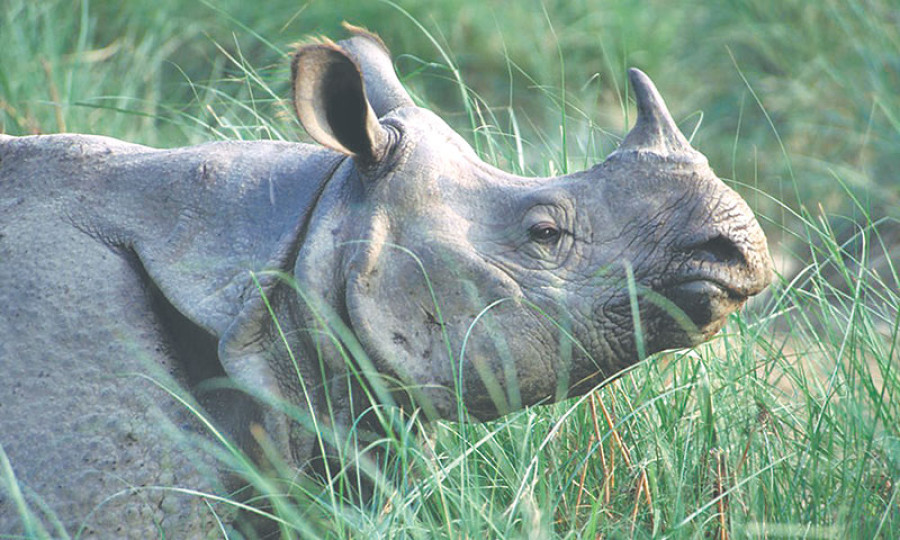Opinion
Rhino diplomacy
Gifting wildlife specimens may boost international ties, but activists have concerns
Umesh Pokharel
The government of Nepal recently gifted a pair of rhinos to the Chinese government as an expression of its intent to sustain and magnify friendly relations with the northern neighbour. According to Prime Minister KP Sharma Oli, the gift further fortifies the historic relations between Nepal and China. Currently, discussions have intensified between the two countries on rail links, energy, tourism, border points and other topics.
Rhino diplomacy is a continuation of Nepal’s animal diplomacy that began in 1985. Nepal has dispatched 26 one-horned rhinos to various countries as diplomatic gifts so far. The first rhino gift was sent to India during the reign of the late king Birendra in 1985. Subsequent recipients are the US, Bangladesh, Pakistan, Thailand, Myanmar, Japan, Germany, Britain and Austria. Nepal has received animals from other countries too. India, Myanmar and Thailand have sent elephants to Nepal in exchange or as gifts.
Mutual respect
It is true that Nepal has become more of a sender than a recipient in terms of animal diplomacy. The context may lead us to hold a suspicion whether this is dignified diplomacy or an act influenced by a desperate and one-way interest. Also, it raises a question if the diplomatic gift strengthens mutual respect on equal ground or endorses an unequal power relation.
Such gifts help to establish connections, sustain relations, make amends, attract attention or prevent possible threats. Importantly, there are a number of examples from other countries where animal diplomacy has been instrumental in reducing tensions and promoting peace. Aafke Komter, in her journal article entitled Gifts and Social Relations: The Mechanisms of Reciprocity published by Sage Publication on behalf of the International Sociological Association, mentions four motives behind gift giving.
The first is expressing friendship, love, gratitude, respect, loyalty or solidarity. The second motivation is based on a need for power and prestige, or inspired by considerations related to reputation and fame. According to her, the third motive is related to psychological expectations of reciprocity and equality. The underlying idea is that favours have to be reciprocated. A fourth class of motives is based on implicit or explicit self-interest. Since the message of the rhino gifts can be interpreted and understood in a number of ways, it is important to know whether or not the recipient country is perceiving the diplomatic message in line with our spirit and intent.
Animal diplomacy began in the ancient Greek period, but Nepal has just started to practice this important form of public diplomacy. The first recorded example of animals being given as diplomatic gifts, as described by Raymond Cohen and Raymond Westbrook in their book Amarna Diplomacy: The Beginnings of International Relations, took place between Nubia and Egypt in the ancient period. Nubia, which was in regular conflict with Egypt but was its subordinate at the time of the pharaoh Tutankhamen, would frequently send giraffes as gifts to the capital. The modern history of animal diplomacy is rather interesting. The most well-known example is China’s panda diplomacy. China has given away or lent a number of pandas to many countries of the world where it wanted to establish and promote diplomatic ties.
Australia’s koala diplomacy presents an example of how animal diplomacy helps to gain global attention in an international forum. During the G-20 summit in Brisbane, Australia in 2014, the world’s most powerful political and economic leaders including Barack Obama and Vladimir Putin, among others, had their photographs taken cuddling the koala. It has been argued that the koala diplomacy virtually sidelined the G-20 agenda in media headlines. Similarly, Indonesia’s dragon diplomacy indicates that not only cute animals but also fearful beasts can be used to send a friendly message. Likewise, Japan attempted to heal age-old tensions with Russia through dog diplomacy.
Public opinion is divided over Nepal’s decision to gift rhinos as a diplomatic gesture. Animal conservation groups and conservationists, in particular, have raised serious objections. In November 2015, for example, a Nepali NGO Animal Nepal submitted a letter to the then minister of forests and soil conservation requesting him not to reintroduce the tradition of gifting wildlife specimens to foreign countries. Conservationists argue that endangered animals suffer greatly while being trapped, transported and resettled. Also, they say that the journey, change in habitat and general management in the new location lead to stress and disease in the gifted animals and affect their wellbeing.
Since Nepal is in the initial phase of learning the art of animal diplomacy, it can find out its strengths, weaknesses, challenges and best practices by studying the examples of China, Australia, Japan and other countries. Australia has termed koala cuddling as the first among other soft power strategies. Similarly, China has described panda diplomacy as one of the successful diplomatic tactics.
Issues and concerns
Nepal can benefit from it equally. However, it has a number of issues and concerns that need to be addressed first. We need to make sure that such diplomacy truly strengthens friendly, equal and dignified relations and doesn’t nurture relations of subordination. Also, we need to ensure that the recipient country understands fully the message we want to convey through animal diplomacy. Further, we need to be serious about the concerns raised by conservationists and try to link animal diplomacy with conservation initiatives. Developing a comprehensive manual to guide animal diplomacy is the answer to all these concerns and questions.
Pokharel is a development communications professional




 5.39°C Kathmandu
5.39°C Kathmandu










%20(1).jpg&w=300&height=200)

